What is intellectual giftedness really?
Research in the area of intellectual giftedness has been rather scarce historically , so this phenomenon today continues to be a terrain for studying and knowing on a necessarily deeper level.
Contributions of American origin make a distinction between the concepts "supergifted" (gifted in all subjects), "gifted (CI greater than 130)" and "talented" (high capacities in some specific subject). More specifically, the American Department of Education indicates six criteria to be met by the student in order to be considered intellectually gifted:
- Possess a general academic excellence.
- Have specific skills
- Have a type of producer thinking.
- A good leadership ability
- Present a talent in the visual and physical arts.
- A superior psychomotor skill.
Thus, the exact definition of what for this group would be a gifted student would correspond to the ability of boys or girls with great precocity in the general development or in the development of specific skills.
The facets of intellectual giftedness
Among the characteristics that distinguish this class of students are three areas: behavior (they are very active and show great interest in their surroundings, their understanding of the environment is very high and have high concentration and memory capabilities), the physical characteristics (an attractive physiognomy is hypothesized and a greater likelihood of using lenses to correct vision) and social adaptation (they show greater maturity, greater independence and their social relationships are usually satisfactory in cases up to an IQ 150 limit, being the opposite for children with higher ratios, in addition, they tend to have more emotional stability, empathy, are interested in intellectual leisure activities and their sense of humor is highly ironic and twisted).
Discrimination of the gifted student
As problems associated with intellectual giftedness can differentiate between the so-called Internal or External Dysynchrony Syndrome and the Negative Pygmalion Effect. The first refers to an alteration in the synchronization with regard to intellectual, social, affective and motor development. Within this particularity, the internal dyssynchrony is included (being able to be intellectual-motor, relative to the language, and to the capacity of reasoning or in the affective-intellectual area) and the social dyssynchrony (both in the school and in the family environment).
On the other hand, the Pygmalion Effect is usually associated with cases of unspecified giftedness in which the figures of the family and / or school surroundings grant low expectations to the student's school performance, which provoke an attitude of conformity and low effort on the part of the student. of the child, combined with a feeling of guilt regarding his precocity that feeds the decrease of his school results.
Typologies of intellectual giftedness
The investigations have found a great heterogeneity in the aspects that characterize the gifted subjects, greater than the points they present in common. A) Yes, a first way to categorize this group of individuals is related to the level of creativity of the same .
1. Creative gifted
On the one hand, the highly gifted creators stand out for having a very developed sense of humor, a powerful nonconformity and differentiation from others. Its main characteristics are associated with a greater capacity in the flow of ideas , originality, skill of abstraction, taking of unusual perspectives and imaginative capacity.
2. Gifted by IQ
On the other hand, the gifted can stand out for their IQ level, and not so much for their creative ability. In this second group are subjects who have approximately an IQ of 140, and can be discriminated between gifted privileged media (characterized by a high critical spirit, nonconformity, impatience, but also enjoy a good self-esteem and positive self-confidence), gifted of disadvantaged medium (more conformist, intensely emotionally sensitive, usually worried about failure and dependent on ethical and moral values) and the gifted who present extreme precocity (they are related to alterations of the personality and obsessive or psychotic psychopathology, so that tend to be marginalized, maladjusted and socially misunderstood individuals).
How to identify the gifted student
Different authors have made different lists of the defining aspects of people with high IQ, very applicable in the detection of gifted students.
For example, contributions from Joseph Renzulli from the Research Institute for the Education of Gifted Students they indicate that there are three criteria that must be taken into account when qualifying a subject as gifted:
- An intellectual capacity above the average
- A high degree of dedication to tasks
- High levels of creativity
- It is also usual to associate these young people with great leadership skills and high artistic and psychomotor abilities. But they are not the only characteristics related to giftedness.
The characteristics of the gifted
The particularities that have been exposed as defining a gifted subject, such as creativity, dedication to tasks to perform or an IQ that really reflects the intellectual capacity of the individual free of foreign variables, are very difficult to assess.
Even so, consensus has been reached to include some aspects as indicators of intellectual giftedness , whose presence is in a high proportion of the cases studied.
Thus, from the family and school environment, the figures of the child's environment can observe the following qualitative and quantitative parameters: the use of language (wide vocabulary and high complexity of sentences), the type of questions posed (unusual, original) , the elaborate way of communicating one's ideas, the ability to design strategies to solve tasks, the innovative use of common materials, the breadth and depth of their knowledge, the marked tendency to collect and have many hobbies (especially intellectuals), and a constant and highly critical attitude.
Psychopedagogical intervention in gifted students
Although there are widespread beliefs about what type of intervention is most appropriate for this group of students, It seems to be proven as the most effective measure the fact of dispensing an inclusion treatment of these subjects in the usual school environment shared by the rest of the students.
Therefore, we must avoid segregation and the integral modification of the academic curriculum or the need to be supervised by a teacher with a specific professional profile. More specifically, the following psycho-pedagogical strategies are proposed in the intervention with gifted children:
Application of the academic curriculum
It must be established individually for each gifted subject (depending on their particularities) , indicating what kind of help will be needed both quantitatively and qualitatively and if this will be informal or will require formal changes in the educational program. Facilitation of stimulating activities should be sought at the level of self-knowledge and hetero-knowledge of the students and opportunities for parents to better understand the characteristics of their children.
The acceleration
This intervention refers to the substitution of an academic course to be carried out by the student for a more advanced one. This resource has the advantage that allows to adapt a more stimulating environment to the student although it is true that the maturity and ability of the gifted student is not equal in all areas, so that he may feel inferior to his classmates in the advanced course and, thus, increase the promotion of competitive attitudes among children.
The support classroom
In this case there is a specialist teaching team assigned specifically to determine what kind of support this type of student needs. Gifted children are taught segregated from their usual partners , establishing a new group of high capacities in which the development of skills and interest in the different areas of learning is worked. The main drawback is that it can facilitate the appearance of rejection by colleagues who do not have high intellectual abilities.
The usual classroom
This strategy is based on the development of learning within the classroom of origin of the student, which shares the same treatment as the rest of the class. The advantage of this methodology is that students do not perceive discrimination or preferences They also learn to adapt and normalize the fact that the learning process occurs heterogeneously in a natural way. The main disadvantage lies in the decrease in the motivation that gifted students can suffer if they do not receive sufficient stimulation.
Curriculum expansion projects
To apply this strategy must pay attention and analyze the type of specific skills presented by the student , the areas of interest, the style of their learning, the condensation (individual adaptation of the curriculum), the evaluation of the product or activity carried out, the proportion of complementary stimulating activities (conferences, exhibitions, fairs, etc).
Family support
The family collaboration is essential since they can facilitate the teaching task and the emotional stability of the student avoiding demotivation or rejection by their classmates.Parents have a greater knowledge of the needs of the child and can complement the need for school stimulation at home. Thus, communication between both parties is fundamental , since it will allow the teaching team to provide them, in addition, with certain appropriate educational guidelines regarding the treatment offered to the child at home in order to avoid comparisons, excessive demands, acceptance of their particularities, etc.
Teaching and training of specific intellectual skills
For a greater enrichment of the acquired contents, the training of the following skills can facilitate learning and motivation for it .
The information and data received can be worked on in aspects such as sequencing, comparison, classification, cause-effect relationship, elaborate lists of attributes, logical reasoning, planning and execution of projects, evaluation of ideas and perspectives, detection and correction of errors, mainly.
Bibliographic references:
- Acereda, A. and Sastre, S. (1998). The giftedness. Madrid: Synthesis.
- Alonso, J. A., Renzulli, J. S., Benito, Y. (2003). International manual of gifted. Madrid: EOS.
- Álvarez González, B. (2000): Students of high abilities. Identification and educational intervention. Madrid: Bruño.
- Coriat, A. R. (1990): Gifted children. Barcelona: Herder.
- Renzulli, J. (1994): "Development of talent in schools. Practical program to enrich the total school performance ", in school BENITO, Y. Through (coor.): The model of intervention and psychoeducational research in gifted students. Salamanca: Amaru Editions.



















